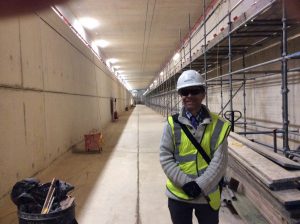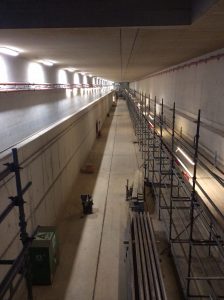Joe Banks and Charles Badoe represented FSI at the 2014 SIMMAN workshop http://www.simman2014.dk/ held in Lyngby Denmark on 8-10 December. This workshop series is aimed at benchmarking the prediction capabilities of different ship manoeuvring simulation methods including systems and CFD based methods through comparison with results for container ship, tanker and surface combatant hull form test cases.
This year’s workshop is following up on the workshop held in 2008, which was the outgrowth of discussions and planning conducted by the 24th and 25th ITTC manoeuvring Committees. CFD based methods were compared with both PMM/CMT and free-model test data. Comparisons for PMM/CMT and free model tests were blind in the sense that the PMM/CMT and free-model test data was not provided prior to the workshop unless data was required as input to the simulation method.
The workshop was organised by FORCE, MARIN and IIHR with assistance and support from the 27th ITTC manoeuvring Committee. Participants of the workshop included, BAE Systems, CNR-INSEAN, ECN/CNRS, Force Technology, Hamburg University of Technology, HSVA, Hyundai Heavy Industries Co. Ltd, Indian Institute of Technology, KAIST, KRISO, MARIN, NMRI, ONR, OSK-Ship Tech, Shanghai Jiao Tong University, Technical University of Berlin, University of Genoa, University of Iowa, University of Michigan, University of Southampton, Wiki Ltd and University of Zagreb and Wuhan University of Technology.
University of Southampton submitted a paper entitled ‘Comparison of various approaches to numerical simulation of ship resistance and propulsion’ by Badoe, C., Winden, B., Lidtke, A.K., Phillips, A.B., Hudson, D.A. and Turnock S.R. The full paper can be found at http://eprints.soton.ac.uk/369875/.

Wavemaker installed
Visit to new tank
The successful case of the optimizer WORHP *** Prof.Joerg Fliege
THURSDAY 11/12/2014 12:00-13:00 B175/1025 Boldrewood Innovation Campus
We are very pleased to invite Professor Joerg Fliege, Director of CORMSIS (Centre for Operational Research, Management Science and Information Systems) at the University of Southampton to deliver an invited seminar on “The successful case of the optimizer WORHP”
WORHP – We Optimize Really Huge Problems. Professor Fliege was part of the development team of the WORHP optimization solver and its processor FGS Toolbox, where he led the development of the multiobjective add-on FGS-MCS. He is presently part of the project team of AWACS (Adaption of WORHP for Avionics Constraints), where he is leading the extension of WORHP to multiobjective problems.
FSI attend the International Conference on Hydrodynamics (ICHD), Singapore, 2014.
This year, two representatives from Southampton FSI attended ICHD in October. James Hawkes presented work on linear solvers for CFD; and Puram Lakshmynarayanana presented an evaluation of hydrodynamic coefficients of a barge using CFD. The conference was hosted at Nanyang Technological University, in Singapore. The venue was close to the International High Performance Computing Centre (IHPC) to which Southampton have strong ties. A seminar was given at IHPC following the conference.

The conference covered a very broad range of hydrodynamics applications – from classical ship hydrodynamics, propeller interactions and cavitation, to coastal pollution flows and flooding simulations. There were four parallel sessions, focusing on different research areas, over the course of four days.
In the ship hydrodynamics sessions there was a strong focus on seakeeping experiments and simulations. There were also interesting presentations focused on manoeuvring, wind-assisted propulsion and sloshing effects.
The two Southampton participants both presented in the Computational Fluid Dynamics session. The session was started by a particularly interesting plenary session by Professor Frederick Stern (University of Iowa) on the recent progress in CFD – looking at simulations for naval architecture and ocean engineering. The CFD sessions were not limited to ship hydrodynamics, and included presentations on acoustic noise simulation from granular sand dune flows; numerical studies on flexible hydrofoils; hull-shape optimization algorithms; and Lagrangian particle simulations of lock-exchange flows.
The full proceedings will be available soon, at http://www.ichd2014.org .
RNLI Advanced Technology Partnership Annual Lecture 3rd Dec
Many of you will be aware of the Advanced Technology Partnership that the University has with the Royal National Lifeboat Institution on Maritime Engineering and Safety (RNLI ATP). One important facet of this relationship is an annual public lecture delivered by a pre-eminent speaker on a topical subject. This year we are pleased to welcome double Olympic gold medallist and TV presenter, Shirley Robertson OBE, as our speaker for the 2014 RNLI ATP Lecture to be held on Wednesday, 3rd of December at the Turner Sims Concert Hall at 6pm.
Refreshments will be served in the foyer from 5:30pm.
For further information please visit the webpage:http://www.southampton.ac.uk/engineering/news/events/2014/12/03_the_rnli_lecture.page
55225_RNLI lecture poster A4_WEB
We look forward to seeing you at this event
The World–Wide Failure Exercises: Strength Prediction Is NOT EASY …. but We’re Getting There !
We are very pleased to invite Professor Mike Hinto, Technology Director of National Composites Centre (NCC) to deliver our FSI/SMMI/LR and material group joint seminar on
The World–Wide Failure Exercises: Strength Prediction Is NOT EASY …. but We’re Getting There !
NCC is one of seven UK Government sponsored ‘High Value Manufacturing Catapult Centres’. Prof. Hinto has more than 40 years of experience of working on programmes on composite materials and structures.
This joint seminar will stimulate discussions and close interaction between academics from different research groups of engineering faculty at the university and the specialists from LR on this interested topic.
Date: Friday, 5th December 2014
Room: Boldrewood campus B175 Seminar Room 1025
Time: 11:30-12:30
New hydrodynamic facility taking shape

 The University of Southampton is developing a new hydrodynamic facility at the recently opened Southampton Boldrewood Innovation Campus. The aim of this facility is to provide a world class fluids facility supporting research, teaching and enterprise across the aerospace, energy, maritime and transportation sectors. This capability will complement the simulation expertise using high performance computing.
The University of Southampton is developing a new hydrodynamic facility at the recently opened Southampton Boldrewood Innovation Campus. The aim of this facility is to provide a world class fluids facility supporting research, teaching and enterprise across the aerospace, energy, maritime and transportation sectors. This capability will complement the simulation expertise using high performance computing.
Construction of the building is nearly complete and its progress since June 2014 has been captured in a time-lapse below (please click the image).

Continue reading New hydrodynamic facility taking shape
FSI/SMMI/LR Sloshing Assessment of Membrane LNGS
Mr. Nigel White, Technical Manager for hydrodynamics in Lloyd’s Register’s Structural Analysis and Hydrodynamics team
 21st November Boldrewood Innovation campus B175 Seminar Room 1025 (entrance through b176) Time: 11:00-12:30
21st November Boldrewood Innovation campus B175 Seminar Room 1025 (entrance through b176) Time: 11:00-12:30
We are limited to 120 spaces for both University of Southampton and LR attendees so prompt attendance is recommended.
Abstract:
Lloyd’s Register is responsible for the development, implementation and maintenance of standards for the design, construction and operation of ships and offshore units. These standards, or ‘Rules’ are supplemented by additional verification procedures which are often assessed using advanced structural analysis techniques or similar direct calculation programs.
One example of this is the assessment of the strength of the LNG cargo containment system to resist sloshing actions, the assessment of the design sloshing loads and the assessment of the structural response and capacities are very complex and a simple definitive procedure is no longer applicable. .
Lloyd’s Register “Sloshing Acceptance Guidance Document for Membrane Tank LNG Operations” gave recommended design methods for the assessment of the cargo containment system. This talk reviews some of the issues associated with the development of this document, related research tasks and also the processes followed by Lloyd’s Register in the design appraisal of LNG cargo containment systems and the recent application to FLNGs.
Biography
Technical Manager for hydrodynamics in Lloyd’s Register’s Structural Analysis and Hydrodynamics team which looks after research and development issues. My role is to look after the research programme for the development of hydrodynamic expertise and capabilities of Lloyd’s Register covering ship motions, hydroelasticity, sloshing, dynamic load application, etc. for all ship types. As such I support Lloyd’s Register’s Classification and Plan Approval offices worldwide on hydrodynamic related issues.
I joined Lloyd’s Register 16 years ago and have been one of the principal engineers on many projects including LR’s Naval Ship Rules, IACS Common Structural Rules for Tankers, IACS Harmonised Common Structural Rules for Oil Tankers and Bulk Carriers. I was the lead author of LR’s Sloshing Assessment Guidance Document and have been involved in many sloshing related studies and approval of all recent membrane tank LNG ships with respect to sloshing issues including the QFlex and the first QMax ships. I was also the lead author on the 2014 released whipping and springing assessment procedure for container ships.
Prior to Lloyd’s Register, I worked for Burness, Corlett and Partners in charge of their computational analysis group for 11 years. I graduated from the University of Southampton in 1978 with a Ship Science degree.
EPSRC Call on making sense of Data
Not sure how relevant this will be to recent discusison as to use of big data in maritime sector but worth exploring maybe?
Making sense from data
The EPSRC Information and Communication Technologies (ICT) Theme is inviting outline proposals that explore how to extract meaning from data.
Issue date: 28 October 2014
Closing date: 06 January 2015 at 16:00
Status: Open
Type: Invitation for outlines
Related themes: ICT, Mathematical sciences
http://www.epsrc.ac.uk/funding/calls/makingsensefromdata/



